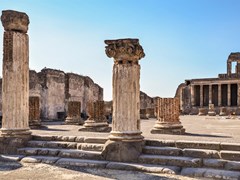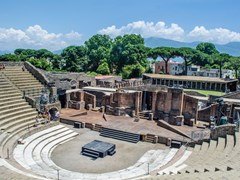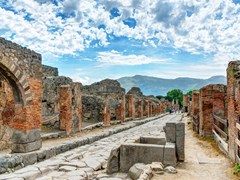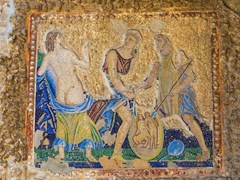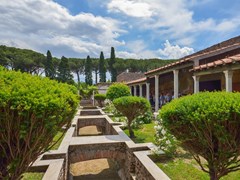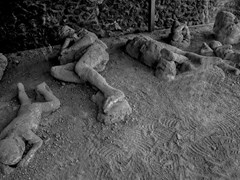Pompeii - the Roman city located at the foot of Mount Vesuvius, near Naples. As a result of the eruption of Vesuvius in 79 AD, the city was almost completely razed to the ground, and was buried under a layer of volcanic ash. Now there is a large open-air museum, which attracts thousands of tourists every year. Pompeii ruins are included in UNESCO World Heritage List.
How to get
The easiest way to get to Pompeii is from Naples by train. Travel time - about 40 minutes. From Naples are made the majority of excursions to Pompeii, including guided tours of the "Mouzenidis Travel".
Scientists do not know exactly how much ancient Pompeii is. It is believed that the oldest building of the city - Temple of Apollo - dates back to VII century BC.
Pompeii was a major cultural center of the Roman Empire, as evidenced by the large number of entertainment buildings (the most famous - an amphitheater for 20 thousand spectators) and a variety of sculptures and statues throughout the city.
The first bell of the impending catastrophe rang in 62 AD. It was a powerful earthquake in the Vesuvius area, which severely damaged Pompeii and neighboring towns - Herculaneum and Kucera. It was not the first earthquake in memory of the inhabitants of Pompeii, so even in the serious damage they are not afraid, and only with great enthusiasm began to rebuild their homes, and even build new ones. For example, baths (baths), which can now be seen in the archaeological park, started to build already in 79, but have not completed.
24 August 79 the volcano Vesuvius woke up. That day the landscape for many kilometers around the volcano changed forever. The eruption lasted all day, completely destroying all life around. Within a few years after the eruption, no one could even remember the exact place where the Pompeii was located, although residents have fled repeatedly tried to find it in order to find something at the ruins of their property.
For the first time in the modern history we learned about Pompeii in 1748, when there have been excavations under the direction of renowned archaeologist Alcubierre. Then scientists believed that they found the legendary city of Stabiae. In 1804 it passed the second excavations, during which found the recording, thanks to which learned that found city is not really Stabiae, but Pompeii.
From 1963 to 1870 the archaeologist Giuseppe Fiorelli found the cause of the destruction of the city. Since 1961, exclusively restoration work carried out in Pompeii.
On the territory of the archaeological complex of great interest to tourists are the temple of Apollo, palestara large amphitheater, ruins of houses, Lupanar, baths and other buildings that have survived to our time.
The amphitheater, which you can see at Pompeii, built in 80 years BC. At the same time it allowed to accommodate up to 20,000 spectators. It is considered one of the most ancient amphitheatres in the world.
Large palestara is an area where in ancient times were different sporting events and theater performances.
Pompeii Forum was the center of social life of the city, and has held a vast territory where at the same time could be the entire population of the city.
Temple of Apollo on historians’ hunches is the oldest building of Pompeii. Presumably it was built in 550 BC. This is a traditional ancient temple surrounded by 28 columns. Unfortunately, only two of them have been preserved.
The Temple of Jupiter is the main temple of Pompeii, which rises majestically from the 3-meter podium in the northern part of the forum. The temple was badly damaged after the earthquake of 62, and reached us only ruins seeing which you can imagine how magnificent it was almost two thousand years ago.
House of the Faun was once one of the richest houses of Pompeii. It covers an area of more than 3 thousand sq. m. Historians believe that the house belonged to Publius Sule, the mayor of the city. At this house was found one of the most popular mosaics of those times, which depicts Alexander the Great on the back of his horse Bucephalus.
House of the Vettii is a relatively small but very rich house, which belonged to a wealthy merchant. The house has been partially restored, so that the tourists could imagine how the noble people of Pompeii had once lived.
In Pompeii there are also many other houses of famous residents, buildings, played an important role in the life of the city, the city fortifications, and various churches, which you can see during the tour.


